Published 26 FEB 2025
Maria Brunner
Acqua Felice
28 FEB until 12 APR 2025
Capitain Petzel is pleased to announce Maria Brunner’s solo exhibition Acqua Felice, opening on February 28, 2025.
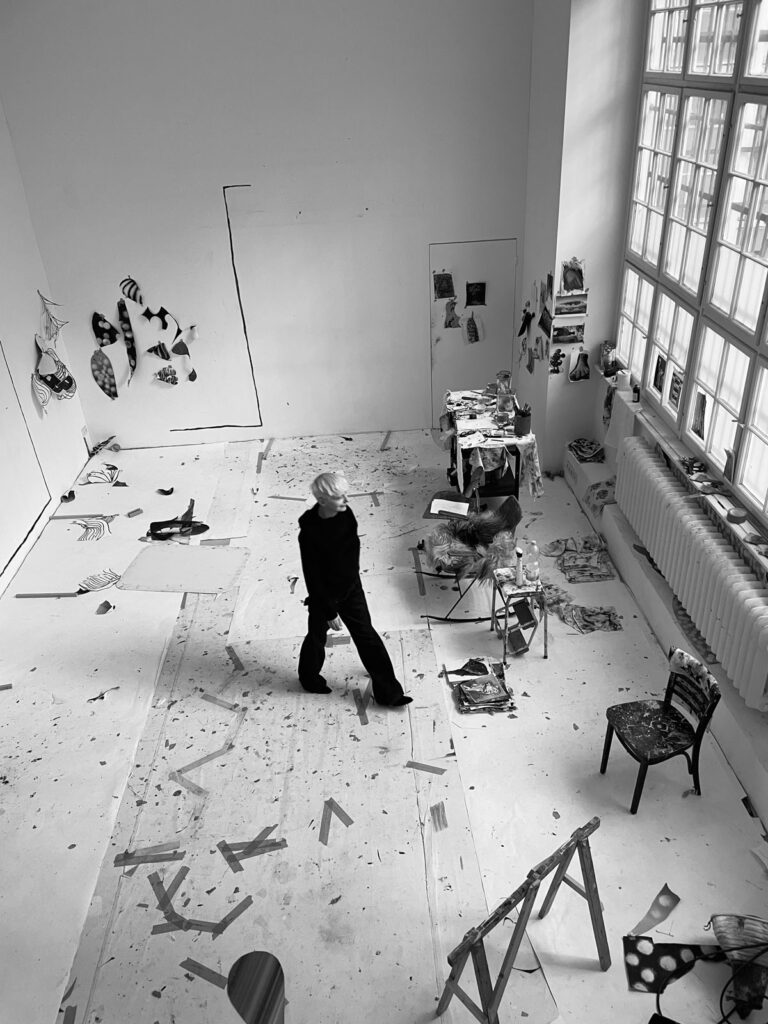
© Maria Brunner.
Courtesy the artist and Capitain Petzel, Berlin.
The exhibition’s title, Acqua Felice, references the historic Roman aqueduct, which once transformed the city’s water supply, echoing Maria Brunner’s engagement with flow and movement. The artist previously worked in a hyper-realistic mode, a process that ultimately became an act of constraint, a self-imposed discipline that led to a rupture. The new body of work in the exhibition marks a return to fundamentals – gesture, material, surface – making a connection to her early drawings. While traces of realism remain, such as a reference to Ernst Mach’s self-portrait drawn from his own perspective in the painting ALLES WALZER, DEIN ERNST, they recede into something more elusive, a fragmented presence.
Maria Brunner’s new body of work unfolds as a meditation on her process. The artist has constructed a space, in which her work is neither confined to the canvas, nor bound to defined representation. The lines painted on the walls of the gallery are to be seen as extensions of the architecture, framing the works and guiding the viewer fluidly through the space.
The gesture of the painted line, both deliberate and instinctual, functions not only as a visual element but as a material inquiry. It is a fine disruptor, altering and simultaneously making the viewer aware of the space it occupies. This exploration of perception has been a continuous thread in Brunner’s practice, recalling the sensibility of her earlier works. In previous series, such as her paintings of folds in fabric, reflections, or lightdappled surfaces, she scrupulously examined the materiality of her subjects. Acqua Felice extends this inquiry by stripping the image down to its essence.
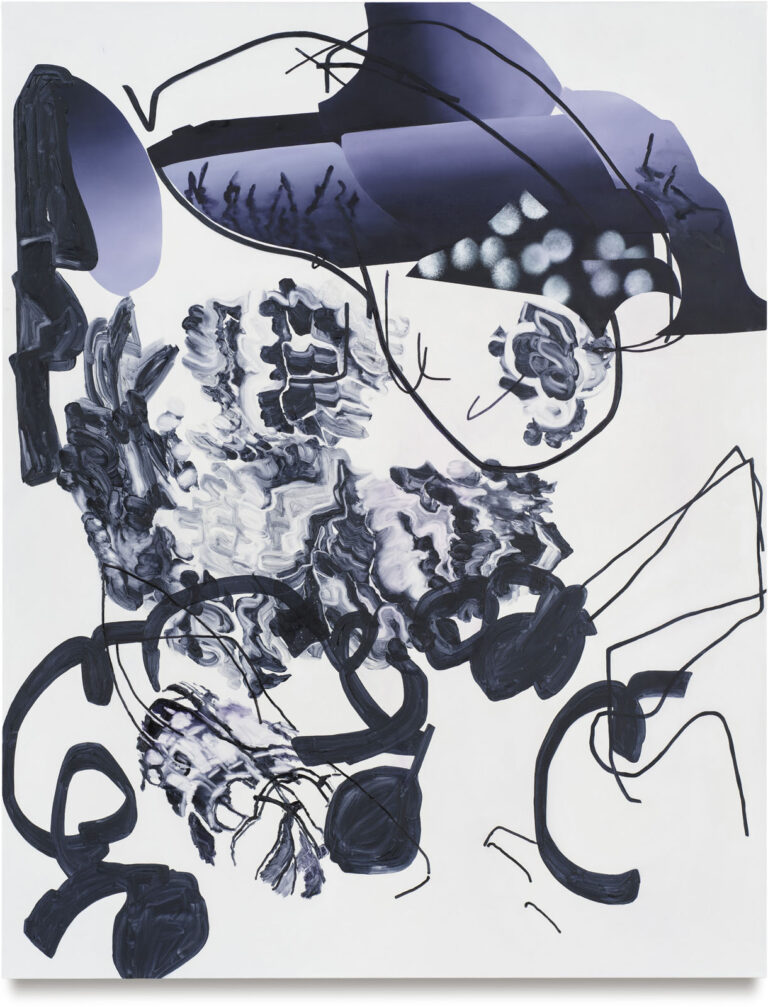
Maria Brunner
SELBSTPORTRAIT ALS JUNGER MANN, 2024
Signed, dated and titled verso
Oil on canvas
230 x 180 cm
90.6 x 70.9 inches
(B-MBRUNNER-.25-0006)
© Maria Brunner. Courtesy the artist and Capitain Petzel, Berlin.
Photo: Gunter Lepkowski
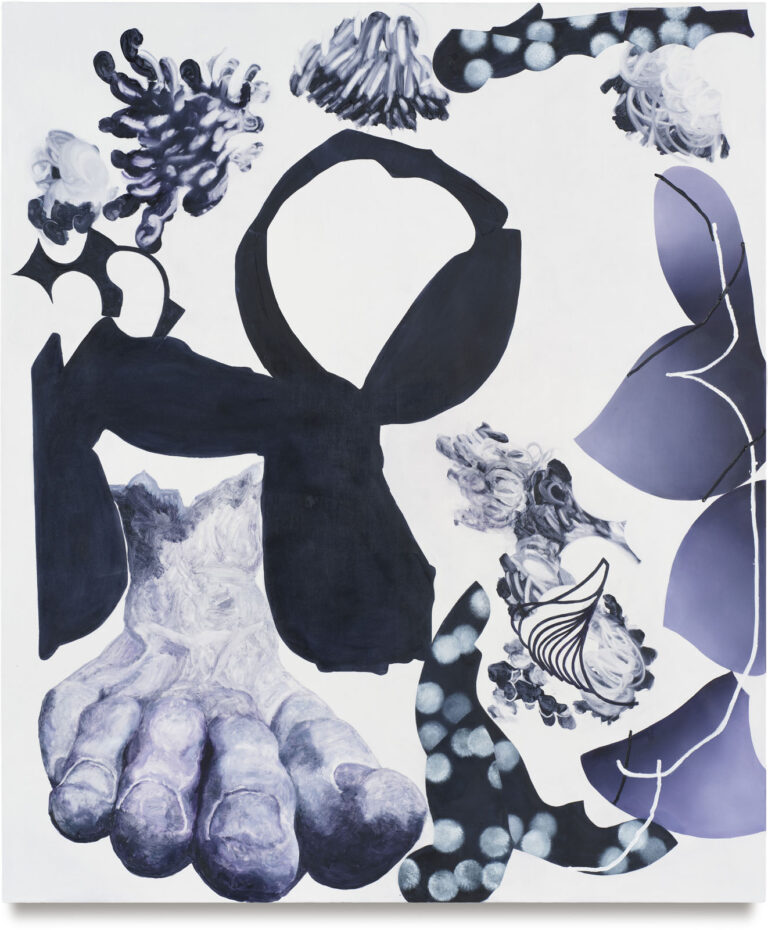
Maria Brunner
GIANT SCHNAUZER, 2024
Signed, dated and titled verso
Oil on canvas
230 x 195 cm
90.6 x 76.8 inches
(B-MBRUNNER-.25-0008)
© Maria Brunner. Courtesy the artist and Capitain Petzel, Berlin.
Photo: Gunter Lepkowski
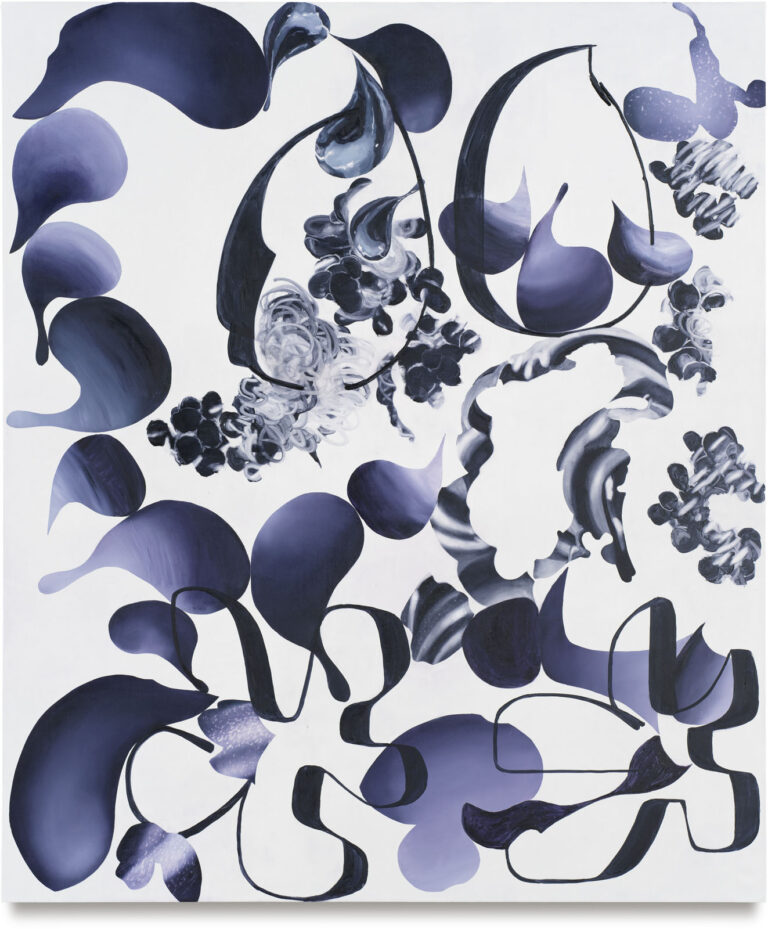
Maria Brunner
17 DROPS A DAY, 2025
Signed, dated and titled verso
Oil on canvas
230 x 195 cm
90.6 x 76.8 inches
(B-MBRUNNER-.25-0011)
© Maria Brunner. Courtesy the artist and Capitain Petzel, Berlin.
Photo: Gunter Lepkowski
The monochrome paintings are executed in Payne’s grey, the sole pigment used in these works. The pigment was developed in the late 18th century by William Payne, initially as a muted alternative to black, often used in watercolor painting for its subtle atmospheric depth. Its fluid, shifting tonality makes it a fitting medium for Brunner‘s exploration of painting, where forms shift between recognition and dissolution.
Maria Brunner (born 1962 in Lienz, Austria, lives and works in Berlin) has held institutional solo exhibitions at Kunstverein Offenburg, Kunst Forum Rottweil and Kunstverein Heilbronn, among others. She participated in group exhibitions at Bundeskunsthalle, Bonn, KW Institute for Contemporary Art, Berlin, Tiroler Landesmuseum Ferdinandeum, Innsbruck, and Museum der Moderne, Salzburg. The artist has been represented by Galerie Gisela Capitain, Cologne, since 1992.
Maria Brunner‘s works are included in the public collections of the Museum of Modern Art, New York, Sammlung Deutsche Bank, Frankfurt, and Tiroler Landesmuseum Ferdinandeum, Innsbruck.
Isabella Ducrot
Altri Fiori
28 FEB until 12 APR 2025
Capitain Petzel is pleased to announce Altri Fiori, Isabella Ducrot‘s third solo exhibition with the gallery, opening on February 28, 2025.
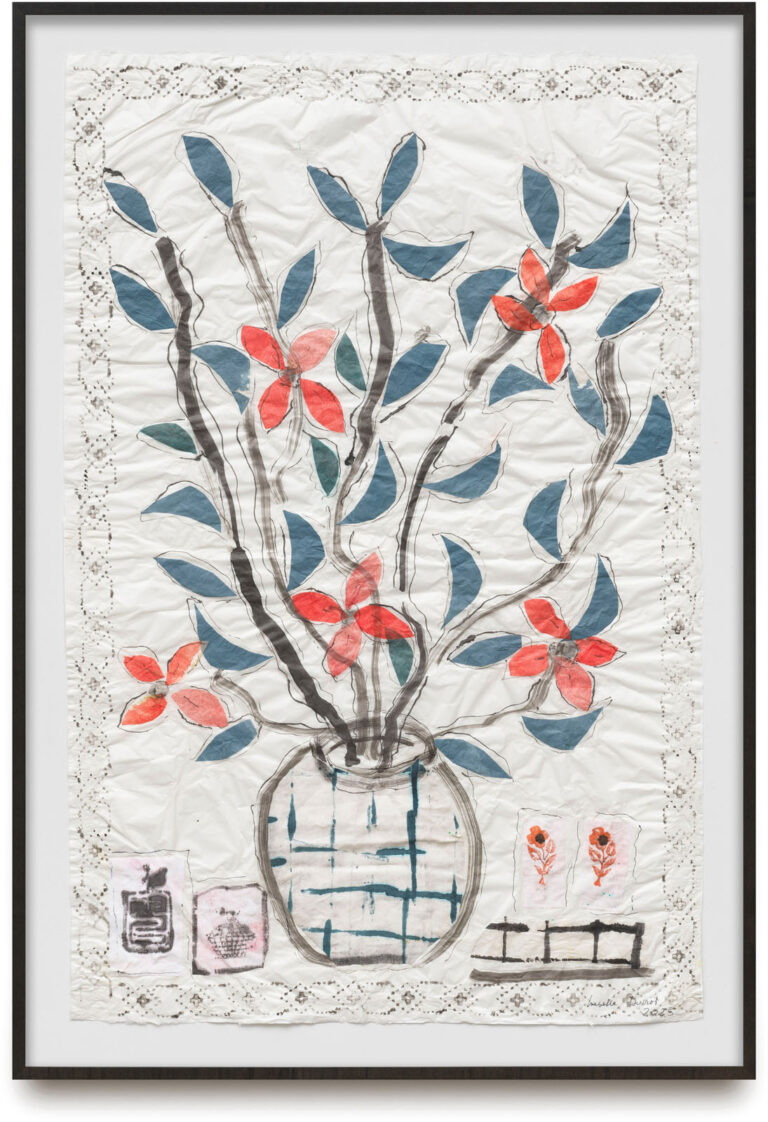
Isabella Ducrot
Checkered Pot, 2025
Signed and dated recto
Pigments, ink, fabrics and collage on paper
96 x 63 cm
37.8 x 24.8 inches
(B-IDUCROT-.25-0010)
© Courtesy the artist and Capitain Petzel, Berlin
Photo: Gunter Lepkowski
Isabella Ducrot is an artist and writer, whose career spans over four decades. In her nineties, she approaches art with an acute sense of immediacy, unburdened by the need to anticipate the future. For her, creation is no longer a preparation for what is to come but a full immersion in the present moment. This immediacy translates into works that feel both intuitive and profound – gestures of pure artistic presence, where the act of making is inseparable from the act of being.
The exhibition showcases Ducrot‘s latest works, focusing on floral motifs. Rather than treating flowers as decorative elements, Ducrot distills their forms into distinct compositions, emphasizing the physicality of her materials. She works with Japanese Gampi paper, a rare and highly prized fiber known for its translucent delicacy yet surprising resilience. This interplay between fragility and strength mirrors the themes of her collaged works, in which floral elements appear almost ethereal, but remain grounded in an enduring material presence. „My work is not delicate“, Ducrot has remarked, underscoring the robustness of both her materials and her artistic vision. Her flowers are not fleeting embellishments but rather solid, elemental forms that embody a quiet permanence.
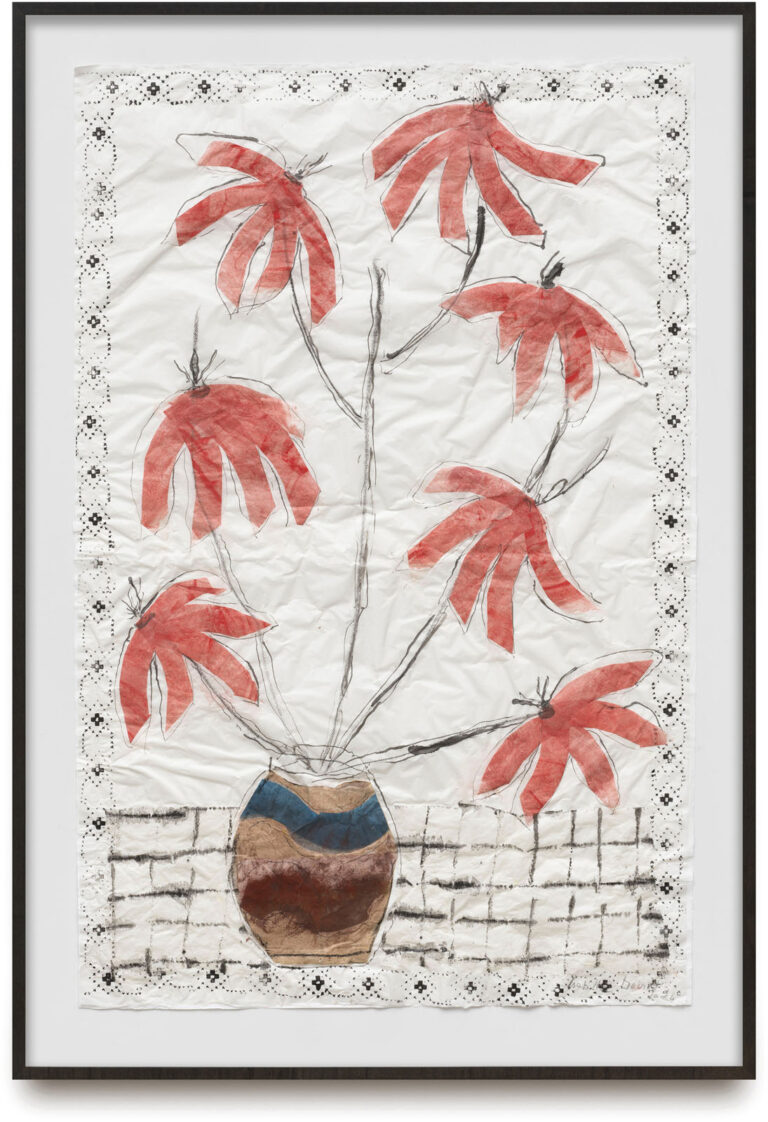
Isabella Ducrot
Red Flowers, 2024
Signed and dated recto
Pastel, pigments, ink and collage on paper
97 x 64 cm
38.2 x 25.2 inches
(B-IDUCROT-.25-0007)
© Courtesy the artist and Capitain Petzel, Berlin
Photo: Gunter Lepkowski
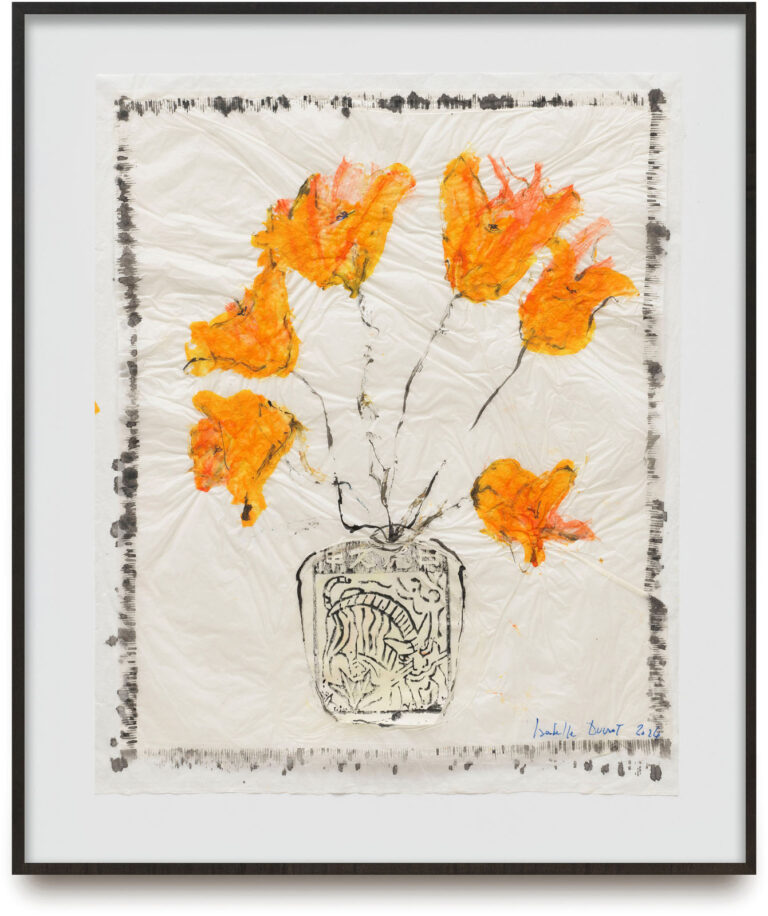
Isabella Ducrot
Trembling Orange Flowers, 2024
Signed and dated recto
Pigments, ink and collage on paper
51 x 42 cm
20.1 x 16.5 inches
(B-IDUCROT-.25-0024)
© Courtesy the artist and Capitain Petzel, Berlin
Photo: Gunter Lepkowski
Throughout her life, Ducrot has undertaken extensive travels, amassing a remarkable collection of fabrics and papers, some of them historical, from Turkey, China, India and Tibet, among other places. In her works in the exhibition, the artist incorporates ancient Indian stamps into her compositions, layering them onto Gampi paper to create a dialogue between personal mark-making and the historical traces embedded in these printed symbols. A wide variety of media, such as pencil, pastel, ink, and watercolor, are applied to the rare papers, weaving together a tapestry of cultural references that encompass philosophy, folklore, and textile traditions.
In 2024, a documentary titled Tenga duro signorina! Isabella Ducrot Unlimited, directed by Monica Stambrini, was released. The film offers an in-depth look at Ducrot‘s life and work over a period of two years. The Madre Museum in Naples is set to present a retrospective of Ducrot‘s work in 2026, curated by Adam Weinberg.
Isabella Ducrot‘s solo exhibition WEAVING IS HUMAN was recently on view at Museo delle Civiltà in Rome. In 2024 Ducrot had a comprehensive solo show at Le Consortium Museum in Dijon. She also created a monumental scenography for Dior‘s spring 2024 haute couture show. Ducrot‘s large-scale installation Omaggio a Mishima (Homage to Mishima) was part of Art Basel‘s Unlimited sector in 2022.
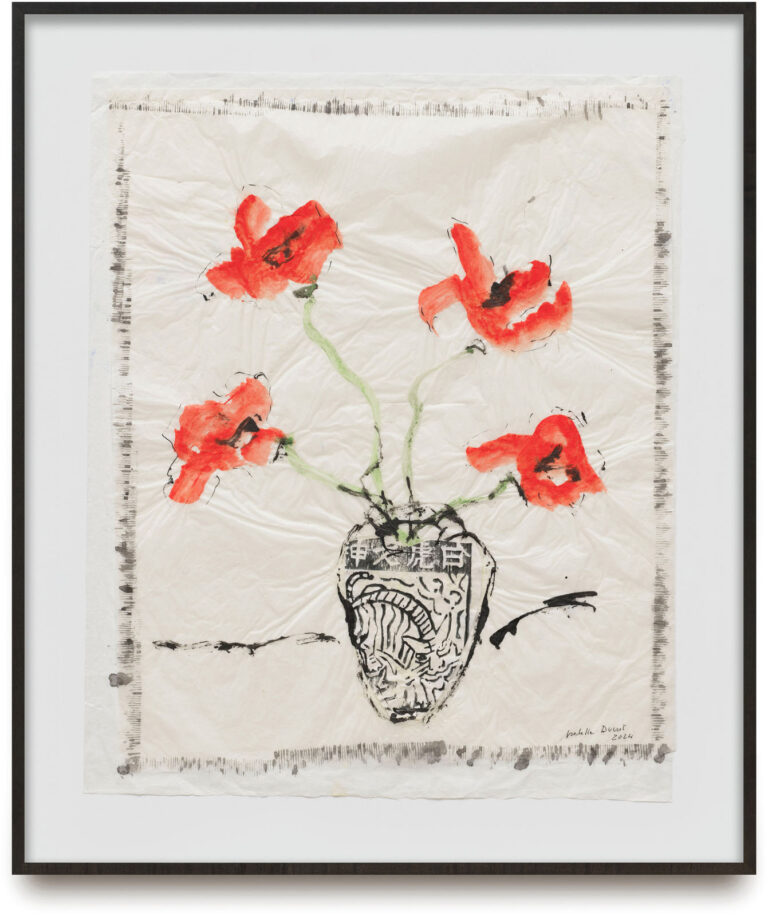
Isabella Ducrot
Trembling Red Flowers III, 2024
Signed and dated recto
Pastel, pigments, ink, fabrics and collage on paper
51 x 42 cm
20.1 x 16.5 inches
(B-IDUCROT-.25-0021)
© Courtesy the artist and Capitain Petzel, Berlin
Photo: Gunter Lepkowski
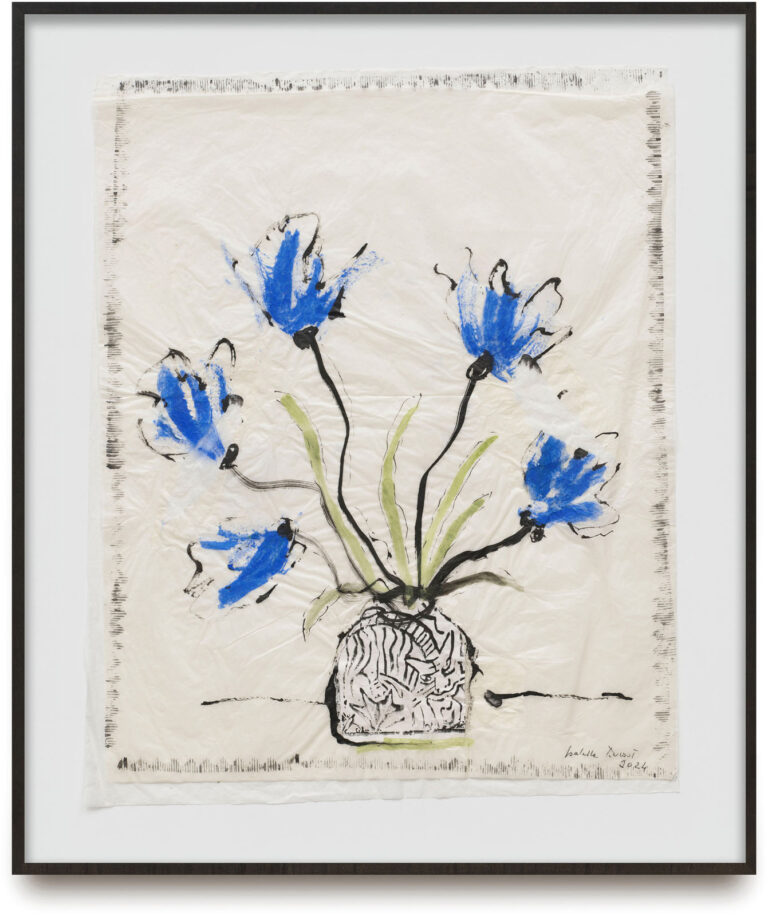
Isabella Ducrot
Trembling Blue Flowers III, 2024
Signed and dated recto
Pigments, ink and collage on paper
51 x 41 cm
20.1 x 16.1 inches
(B-IDUCROT-.25-0023)
© Courtesy the artist and Capitain Petzel, Berlin
Photo: Gunter Lepkowski
